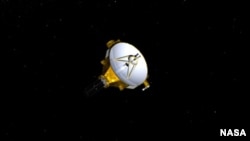On Saturday, the U.S. spacecraft New Horizons is set to 'wake up' in preparation for a six-month encounter with the dwarf planet Pluto, on the outer edge of the solar system.
The NASA space probe New Horizons, launched in January 2006, is in the final stretch of its mission to the small rocky frozen dwarf planet at the far end of the solar system.
Now some 4.8 billion kilometers from home, the spacecraft has spent two-thirds of its journey in slumber to preserve instrumentation that will be used to closely study Pluto during a brief 22-hour fly-by next year. Sometime this Saturday afternoon, U.S. East Standard Time (EST), the probe will be awakened.
Alice Bowman, New Horizons mission operations manager at the Johns Hopkins University Applied Physics Laboratory in Maryland, says a sleep-and-wake-up cycle has been a regular feature for the highly unusual mission.
“This is the 18th hibernation that we have had the spacecraft in since launch," she said. "I know nothing in space exploration is routine, but for us, putting the spacecraft into hibernation and then having it wake up as planned, it is somewhat routine for us."
New Horizons is so far away from Earth, it takes approximately four-and-a-half hours for a command to reach the probe and several more hours for New Horizons' confirmation to return to mission control.
So Bowman and the other New Horizons scientists will not know until nighttime (approx 9:30PM EST) for sure whether the space probe fully emerged from its slumber.
During hibernation periods, the spacecraft has been zipping unpowered through deep space, at times traveling as fast as 22 kilometers per second following a gravity assist from Jupiter.
New Horizons is traveling so fast, it took nine hours to reach the Moon, a distance that the manned lunar missions took three days to cover.
Onboard flight computer monitors keep watch over the spacecraft’s health, sending back a weekly beacon-status tone. And three onboard instruments have been passively collecting data along the way. That information will be downloaded to Earth once New Horizons becomes fully awake.
At that point, the spacecraft will be only 260 million kilometers from Pluto.
The temperature on the icy rock is estimated to be minus 229 degrees Celsius, meaning its atmosphere, if it has one, is frozen.
Eventually, scientists like Bowman expect that Pluto will have drifted so far from the sun, any atmosphere it has will collapse on itself.
“I think everyone is beginning to realize that Pluto and objects like it are more the norm in our solar system than the rocky planets and the gas giants that we are all so familiar with," she said.
New Horizons’ first encounter with Pluto, which is 30 times farther from the Sun than Earth, is slated to begin on January 15, 2015. The actual fly-by will last for just over 20 hours, beginning on July 14. The probe will also train its instruments on Charon, Pluto's large moon.
After that, scientists plan on using New Horizons’ remaining propellant to guide it out into the Kuiper belt, a region of space beyond the planets of our solar system, for further exploration.







